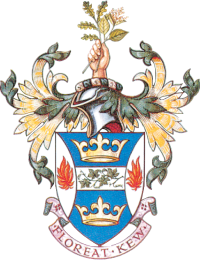Robert Cross entered Kew as a gardener in June 1857 and left in 1859. He came to play a major role in the initiatives to establish cinchona and rubber in eastern Asian countries. In 1859 the India Office requested Kew to assist in the establishment of Cinchona succirubra, ‘Red Bark’ or Peruvian Bark’, the source of antimalarial quinine, in India. In 1859, recommended by William Hooker, Cross was selected to join Yorkshire botanist Richard Spruce on an expedition to Ecuador to collect it. Delayed by illness and a local war, they eventually reached the foothills of the Andes in 1860 and collected more than 100 000 ripe seeds (which were despatched to Kew) and more than six hundred cuttings and seedlings. Cross was responsible for the safe passage of the young plants (in Wardian cases) to Britain, which included a hazardous trip by mule and raft to the coast. Plants were then sent to India, and by 1880 some 15 000 acres were in cultivation there. The Botanic Garden at Peradeniya in Ceylon also established a mountain nursery at Hakgala solely for cinchona, and Kew sent a gardener, Mr M’Nicoll, to take charge of it.
Following this success, Cross was re-employed for further expeditions to Central and South America. Over the next ten years he made four more trips. He collected Cinchona officinalis in Loxa, then on three visits to Pitaya collected Pitayo Cinchona. He was then involved with collecting from rubber trees.
Now chosen by Joseph Hooker, in 1875 Cross left for Central America seeking Castilla elastica. Before the adoption of Hevea this was considered to provide the best rubber. On the return voyage the ship carrying Cross and his 600 plants ran onto a reef off the coast of Jamaica. While most passengers were taken off, Cross stuck by his plants and was eventually taken on board HMS Dryad. Sadly none of the 7000 seeds collected germinated, but his cuttings flourished at Kew and were distributed to West Africa, Ceylon, India and Java.
In 1876, again supported by Joseph Hooker, he sailed to Pará, Brazil, for Hevea brasiliensis, the source of the best natural rubber, returning five months later with just over a thousand seedlings. On this trip he worked with a trader in rubber, Henry Wickham. Four hundred seedlings were retained at Kew, with about a hundred of these plants going on to Ceylon, the country considered to be the most suitable in South Asia for the propagation and distribution of rubber to India and Burma. He also brought back some 40 plants of Ceara Rubber, Manihot glaziovii.
In all, Cross made seven trips to South America but his health, like that of Spruce, suffered from service in that region. He was said to be of a retiring nature, ‘a typical Scotsman, with grit’, who penetrated parts of Panama that even the native people were afraid to enter because of its supposed deadly climate.
The Goods Inwards and Outwards lists of plants sent to and from Kew, held in the Kew Archives, contain multiple entries for Robert Cross, e.g.
Goods Inwards 1859–1867 f. 92: ‘Mr R. Cross of Mr Spruce’s Cinchona Expedition. 6 plants C. Succirubra – the smallest selected from the 15 Wardian cases, which were forwarded to India to day.’
Goods Inwards 1868–1872 f. 313: ‘From Mr Cross. 6 plants of Cinchona.’
Sources
Anonymous (1912), In memoriam, Robert MacKenzie Cross, Journal of The Kew Guild 1911, pp. 51–52.
Desmond, R. (1992), The European Discovery of the Indian Flora, Oxford University Press, Oxford.
Desmond, R. (1994), Dictionary of British and Irish Botanists and Horticulturists, Taylor & Francis, & The Natural History Museum, London, p. 180.
Markham, C. (1880), Peruvian Bark : A Popular Account of the Introduction of Chinchona Cultivation into British India : 1860–1880, John Murray, London.
Rocco, F. (2003), The Miraculous Fever-Tree: Malaria, Medicine and the Cure that Changed the World, HarperCollins, London.

